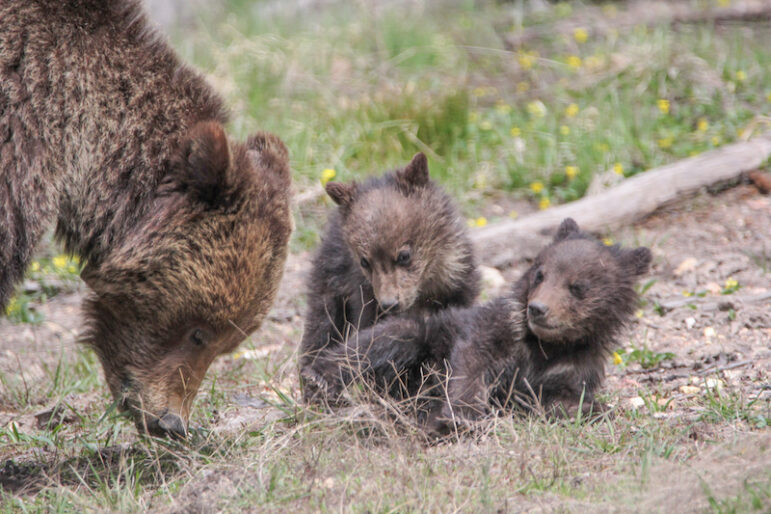The Grizzly bear is an American wildlife icon, and a key component of our unique Western wildlife heritage. Lewis and Clark wrote about encountering grizzly bears when they explored the West more than 200 years ago.
This year, the U.S. Fish and Wildlife Service (FWS) is making progress on restoring grizzly bears to two ecosystems in the West, where grizzlies have long been absent: the North Cascades in north-central Washington, and the Bitterroots along the Montana-Idaho border. ESC has field staff working on the ground in both regions.
In the Washington, the National Park Service is leading the planning process to reintroduce grizzly bears into the North Cascades National Park. Because this ecosystem is far removed—and therefore isolated—from its counterparts further east in Idaho and Montana, the capture and translocation of a handful of grizzly bears over a long period of time is necessary to reestablish a healthy, self-sustaining population here. ESC has been engaged in the public process around the North Cascades. We are supportive of efforts to reintroduce grizzly bears into this area, as well as efforts to educate residents and visitors on how to live and recreate in grizzly bear habitat in ways that minimize grizzly bear interactions with people and livestock.
Over in the Bitterroot Ecosystem, the FWS was recently ordered by a court to restart the long-stalled-out process of considering how to restore grizzly bears to the mountains of western Montana and north-central Idaho. Twenty years ago, the FWS developed and released a plan to reintroduce grizzlies here, but it was scrapped as a result of political meddling by the Bush Administration. Unlike in the North Cascades, however, during the past two decades a handful of grizzly bears have migrated naturally into the Bitterroots. Unfortunately, they haven’t remained, and we don’t know for sure if there are any grizzly bears currently living there, especially female bears necessary to grow a population. Now the FWS must reconsider whether or not to reintroduce grizzlies to the Bitterroots, or to allow a population to reestablish naturally. ESC is carefully considering the best approach to recovering grizzly bears in the Bitterroots. We aren’t sure that an aggressive reintroduction program in such a politically-charged region will be the best way forward for bears. Regardless of the path chosen by the FWS, the conservation of key wildlife corridors and the careful management of bear attractants (garbage, livestock, pet food, etc) around the edges of the recovery area will be critical to ensure successful recovery.
Finally, the FWS is currently considering petitions from the states of Montana and Wyoming to remove Endangered Species Act protections for the growing bear populations around Yellowstone and the Northern Continental Divide. Recently-passed legislation and other policy changes in Montana for wolves, grizzly bears and large carnivores generally give us great pause when considering the ability or desire of Montana to continue to responsibly conserve grizzly bears without strong federal oversight. Furthermore, past attempts to delist grizzly bears have demonstrated a lack of willingness by the FWS to put strong sideboards into rules that would hold the states’ accountable for grizzly bear conservation post-delisting. Therefore, ESC opposes delisting of grizzly bear populations in these recovery areas at this time. As one of the slowest-reproducing mammals on the planet, grizzly bear populations will always be sensitive to mortality, and thus will require continuous, strong conservation measures. As such, any delisting rule or post-delisting regulatory framework MUST include robust and enforceable standards to ensure that grizzly bears thrive into the future. ESC will continue to push for such measures, if any when the USFWS proposes delisting, while advocating for increased landscape connectivity, as well as funding for wildlife crossing projects, attractant management, and other coexistence measures.




6 comments on “Grizzly Bear Recovery in the West: What’s on Tap in 2024”
Be kind to the bears ,this is their world to live in aswel as ours . Leave them in peace to live
Has Endangered Species Coalition ever been involved in the aspect of possible Grizzly Bear reintroduction in the San Juan/Rio Grande Mountains of southern Colorado? Based upon your organizations contacts and associates throughout the west, what would be your assessment of the possibility of achieving such an endeavor… Your thoughts are sincerely appreciated.
Hi Scott. Great question. The GB recovery plan does in fact mention (barely) the San Juans as a potential recovery area for grizzlies. However, they stopped short of designating the area as an official Recovery Zone in the plan. Ecologically, I think it would be highly successful: there is more public land than the Yellowstone Ecosystem, and at least as much food biomass (deer & elk) available. Would it be politically achievable? I don’t know. We’ll have see how wolf restoration in Colorado goes. There are also a few other officially designated recovery zones for grizzlies–two of which have no bears yet–and are higher priories for recovery right now.
Thanks.
Hopefully the Grizzly bears will also be reintroduced to California since they are on the State flag.
Hopefully the Grizzly bears will also be reintroduced to California since they are part of its state flag.
Packing Grizzlies off to California is a GREAT Idea. Especially the very Northern part. It might confuse the Salmon recovery in the Klamath river basin . And come into conflict with the local SASQUATCH population, but O-Well Grizz. Have priority.